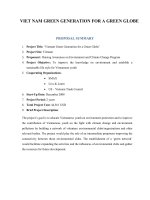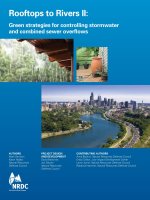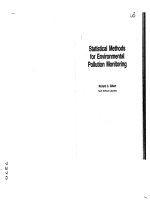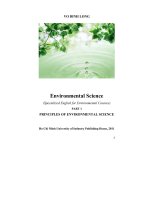Green chemistry for environmental remediation
Bạn đang xem bản rút gọn của tài liệu. Xem và tải ngay bản đầy đủ của tài liệu tại đây (13.86 MB, 790 trang )
Green Chemistry
for Environmental Remediation
Scrivener Publishing
3 Winter Street, Suite 3
Salem, MA 01970
Scrivener Publishing Collections Editors
James E. R. Couper
Richard Erdlac
Norman Lieberman
W. Kent Muhlbauer
S. A. Sherif
Ken Dragoon
Rafiq Islam
Peter Martin
Andrew Y. C. Nee
James G. Speight
Publishers at Scrivener
Martin Scrivener ()
Phillip Carmical ()
Green Chemistry
for Environmental
Remediation
Edited by
Rashmi Sanghi
and
Vandana Singh
Scrivener
©WILEY
Copyright © 2012 by Scrivener Publishing LLC. All rights reserved.
Co-published by John Wiley & Sons, Inc. Hoboken, New Jersey, and Scrivener Publishing
LLC, Salem, Massachusetts.
Published simultaneously in Canada.
No part of this publication may be reproduced, stored in a retrieval system, or transmitted in any
form or by any means, electronic, mechanical, photocopying, recording, scanning, or otherwise,
except as permitted under Section 107 or 108 of the 1976 United States Copyright Act, without
either the prior written permission of the Publisher, or authorization through payment of the
appropriate per-copy fee to the Copyright Clearance Center, Inc., 222 Rosewood Drive, Dan vers,
MA 01923, (978) 750-8400, fax (978) 750-4470, or on the web at www.copyright.com. Requests to
the Publisher for permission should be addressed to the Permissions Department, John Wiley
& Sons, Inc., Ill River Street, Hoboken, NJ 07030, (201) 748-6011, fax (201) 748-6008, or online at
/>Limit of Liability/Disclaimer of Warranty: While the publisher and author have used their
best efforts in preparing this book, they make no representations or warranties with respect
to the accuracy or completeness of the contents of this book and specifically disclaim any
implied warranties of merchantability or fitness for a particular purpose. No warranty may
be created or extended by sales representatives or written sales materials. The advice and
strategies contained herein may not be suitable for your situation. You should consult with a
professional where appropriate. Neither the publisher nor author shall be liable for any loss
of profit or any other commercial damages, including but not limited to special, incidental,
consequential, or other damages.
For general information on our other products and services or for technical support, please
contact our Customer Care Department within the United States at (800) 762-2974, outside the
United States at (317) 572-3993 or fax (317) 572-4002.
Wiley also publishes its books in a variety of electronic formats. Some content that appears in
print may not be available in electronic formats. For more information about Wiley products,
visit our web site at www.wiley.com.
For more information about Scrivener products please visit www.scrivenerpublishing.com.
Cover design by Russell Richardson
Library of Congress Cataloging-in-Publication Data:
ISBN 978-0-470-94308-3
Printed in the United States of America
10 9 8 7 6 5 4 3 2 1
Contents
Foreword by Robert Peoples
PART 1 Green Chemistry and Societal
Sustainability
xix
1
1.
Environment and the Role of Green Chemistry
3
Rashmi Sanghi, Vandana Singh and Sanjay K. Sharma
1.1 The Environmental Concern
3
1.2 The Role of Chemistry
5
1.3 Sustainable Development
7
1.4 Era of Green Chemistry
8
1.4.1 Twelve Principles of Green Chemistry [1]
10
1.4.2 Objectives of Green Chemistry
11
1.4.3 Views of Green Chemistry Experts
12
1.4.4 Concepts Related to Green Chemistry:
Cause of Confusion
17
1.4.5 International Initiatives for Green Chemistry
Awareness
18
1.5 Concluding Remarks
29
Acknowledgement
30
References
30
Suggested Reading: Some Books on Green Chemistry 32
Useful Resources for Green Chemistry
and their Links
33
2.
The Greening of the Chemical Industry: Past, Present
and Challenges Ahead
Fernando J. Diaz Lopez and Carlos Montalvo
2.1 Introduction
2.2 From Greening Technologies to Greening
the Economy
35
36
38
v
CONTENTS
2.3 A Brief Note on Business Strategy
and Corporate Greening
2.4 The Past: An Account of the Historical Relationship
Between the Chemical
Industry and the Environment
2.5 The Present: From Pollution Control to Corporate
Environmental Sustainability
2.6 The Future: Environmentally Sustainable
Manufacturing and Eco-innovation
2.7 Conclusion: Greening or Sustainability
in Chemical Manufacturing?
References
Designing Sustainable Chemical Synthesis:
The Influence of Chemistry on Process Design
Laura A. Anderson and Michael A. Gonzalez
3.1 Introduction
3.2 Green Chemistry
3.3 Green Engineering
3.4 Sustainability Metrics
3.5 Designing a Sustainable Process
3.6 Merck Case Study
3.7 Conclusion
References
Green Chemical Processing in the Teaching
Laboratory: Microwave Extraction
of Natural Products
S. Périno-Issartier, F. Visinoni, F. Chemat
4.1 Introduction
4.2 Microwave versus Conventional Heating
4.3 Experimental
4.3.1 Hydrodistillation (HD) Procedure
4.3.2 Microwave Hydrodiffusion and Gravity
Procedure
4.3.3 Analysis of Essential Oil
4.4 Advantages
4.4.1 Green Production Rapidity
4.4.2 Green Production Efficiency
4.4.3 Green Production Courses
4.4.4 Green Production Messages
4.4.5 Safety Considerations
44
46
51
64
69
71
79
79
83
85
88
89
100
103
104
107
107
110
111
111
112
113
114
114
115
115
116
116
CONTENTS
4.5 Conclusion
Acknowledgements
References
5.
6.
Ensuring Sustainability through Microscale
Chemistry
Norita Mohamed, Mashita Abdullah
and Zurida Ismail
5.1 Introduction to Microscale Chemistry
5.2 Development of Microscale Chemistry Experiments
for Upper Secondary Schools
5.2.1 Microscale Chemistry Experiments
5.2.2 Cost-benefit Analysis
5.3 Teachers' Evaluation
5.3.1 Workshops
5.3.2 Focused Group Discussions
5.4 Students' Feedback
5.4.1 Analyses of Open Comments
from Students
5.4.2 Interviews
5.5 Conclusion
References
Capability Development and Technology Transfer
Essential for Economic Transformation
Surya Pandey and Amit Pandey
6.1 Introduction
6.2 The Importance of R&D
6.2.1 Research and Development
Expenditure
6.3 Knowledge Creation and Technology Transfer
6.3.1 Development of an RDT Voucher
System
6.3.2 External Engagement
6.3.3 Organizational RDT Planning
6.3.4 Structural Changes
6.4 Technology Transfer Future
6.5 Applications to Green Chemistry
6.6 Conclusions
Acknowledgements
References
vii
117
118
118
119
120
122
122
128
130
130
130
131
131
132
134
135
137
138
138
141
145
146
146
147
148
148
149
150
150
151
viii
CONTENTS
PART 2 Green Lab Technologies
7.
153
Ultrasound Cavitation as a Green Processing Technique
in the Design and Manufacture of Pharmaceutical
Nanoemulsions in Drug Delivery System
155
Siah Ying Tang, Khang Wei Tan
and Manickam
Sivakumar
7.1 Introduction
156
7.2 Types of Emulsion and Principles
of Nanoemulsion Formation
157
7.3 Formulation Aspects of Nanoemulsion
159
7.4 The Ultrasonic Domain
160
7.5 What is Ultrasound Cavitation?
163
7.6 Ultrasound Generation
166
7.7 Principle and Operation of Ultrasound
Emulsification
167
7.8 Types of Ultrasound Emulsification: Batch and
Dynamic Systems
170
7.9 Advantages of Ultrasound Emulsification
171
7.10 General Reviews of Ultrasound Emulsification
173
7.11 Nanoemulsion in Pharmaceutical Application
180
7.12 Characterization of Nanoemulsion
Drug Delivery System
184
7.12.1 Particle Surface Morphology and Size
Distribution
184
7.12.2 Solubility Enhancement
187
7.12.3 Drug Encapsulation and Loading
Efficiency
188
7.12.4 Drug Release
189
7.12.5 Ultrasonic-mediated Drug Release
190
7.12.6 Site Specific Drug Targeting
193
7.12.7 Stability
194
7.13 Practical and Potential Applications of Nanoemulsion
in Different Administration Routes
194
7.13.1 Parenteral Drug Delivery
195
7.13.2 Oral Drug Delivery
196
7.13.3 Topical Drug Delivery
199
7.14 Conclusion
200
Acknowledgement
201
References
201
CONTENTS
8.
9.
Microwave-Enhanced Methods for Biodiesel
Production and Other Environmental Applications
Veera Gnaneswar Gude, Prafulla D. Patil,
Shuguang Deng, Nirmalakhandan
8.1 Introduction
8.2 Microwave Energy
8.2.1 Microwave Energy as a Heat Source
8.2.2 Microwave-Enhanced Biodiesel
Synthesis
8.3 Biodiesel Production Using Different
Feedstock
8.3.1 Biodiesel Production from Edible and
Non-edible Oils
8.3.2 Biodiesel Production from Algae
8.4 Energy Consumption
8.4.1 Kinetics Study
8.4.2 Comparison Between Supercritical and
Microwave Assisted Algal Biodiesel
Production
8.5 Analysis of Algal Biomass and Biodiesel
8.5.1 TEM Analysis of Algal Biomass
8.5.2 GC-MS Analysis of Algal Biodiesel
from Wet Algae
8.5.3 TLC Analysis of Algal Biodiesel
from Dry Algae
8.6 Current Status of the Microwave Technology for
Large Scale Biodiesel Production
8.7 Other Microwave-enhanced Applications
8.7.1 Microwave Applications in
Organic Synthesis
8.7.2 Microwave Applications for Green
Environment
8.8 Summary
References
Emergence of Base Catalysts for Synthesis of Biodiesel
B. Singh, S.N. Upadhyay, Dinesh Mohan,
Y.C. Shartna
9.1 Introduction
9.2 Mechanism of Heterogeneous Catalysis
ix
209
210
212
212
215
218
218
221
229
231
233
235
235
236
237
238
240
240
242
244
246
251
252
252
CONTENTS
9.3 Calcium Oxide and Magnesium Oxide
9.4 Hydrotalcite Doped Compounds
9.5 Alumina Loaded Compounds
9.6 Zeolite
9.7 Conclusions
Acknowledgement
References
Hydrothermal Technologies for the Production
of Fuels and Chemicals from Biomass
D.W. Racketnann, L. Moghaddam, T.J. Rainey,
CF. Fellows, P.A. Hobson and W.O.S. Doherty
10.1 Introduction
10.2 Thermochemical Processes for Biomass
10.2.1 Gasification
10.2.2 Pyrolysis
10.2.3 Direct Liquefaction
10.3 Green Chemistry and Hydrothermal
Liquefaction
10.3.1 Upgrading Biocrude Oils
10.4 Hydro-Deoxygenation Upgrading
10.5 Zeolite Upgrading
10.5.1 Zeolite Upgrading of Pyrolysis
Bio-oils
10.5.2 Zeolite Upgrading of Liquefaction
Biocrude
10.5.3 Bio-oil Emulsification
10.5.4 Steam Reforming Bio-oil
10.5.5 HTU® technology
10.5.6 Thermal Depolymerization Process (TDP)
Technology
10.6 Conclusions
References
Ionic Liquids in Green Chemistry Prediction of Ionic Liquids Toxicity Using
Different Models
Raquel F. M. Frade
11.1 Introduction
11.1.1 Ionic Liquids
11.1.2 Ionic Liquids: Applications
253
260
269
278
284
286
286
291
292
295
298
300
304
315
317
318
320
321
323
323
324
327
332
336
338
343
343
343
345
CONTENTS
11.1.3 Ionic Liquid Toxicity
11.2 Conclusions
References
Nano-catalyst: A Second Generation Tool for Green
Chemistry
Archna Rani, Sapna Jain and Sanjay K. Sharma
12.1 Introduction
12.2 Nanocatalyst: An Origin of a Green Concept
12.3 Recent Advances in Nanocatalysis
12.3.1 Synthesis of Nano-catalysts
12.3.2 Applications
12.4 Challenges and Future Scope
12.5 Conclusion
Acknowledgements
References
Green Polymer Synthesis: An Overview on Use of
Microwave-Irradiation
Anuradha Mishra, Rashmi Dubey
13.1 Introduction
13.2 Radical Polymerization
13.2.1 Free Radical Homopolymerization
13.2.2 Free Radical Copolymerizations
13.2.3 Synthesis of Composites by Free Radical
Polymerization
13.2.4 Emulsion Polymerization
13.2.5 Controlled Radical Polymerization
13.3 Step Growth Polymerization
13.3.1 Synthesis of Poly(amide)s
13.3.2 Synthesis of Poly(imide)s
13.3.3 Synthesis of Poly(ether)s
13.3.4 Synthesis of Poly(ester)s
13.3.5 Synthesis of Poly(urea)s and
Poly(urethane)s
13.3.6 Synthesis of Poly(anhydride)s
13.3.7 Synthesis of Poly(amide-imide)s,
Poly (amide-ester)s, Poly(ether-ester)s,
Poly(ester-imide)s, Poly (ether-imide)s,
Poly(amino-quinone) and other
Polycondensation Reactions
13.3.8 Copolymerization
xi
346
352
352
357
358
358
361
361
363
369
370
370
370
379
380
385
386
387
390
391
392
394
395
397
398
398
399
400
400
402
xii
CONTENTS
13.4 Ring Opening Polymerization
13.4.1 Ring Opening Polymerization of
Cyclic Esters
13.4.2 Enzyme Catalyzed Ring Opening
Polymerization
13.4.3 Cationic/Anionic Ring
Opening Polymerizations
13.4.4 Ring Opening Copolymerization
13.5 Polymer Modifications
13.5.1 Polymer Crosslinking/Curing
13.5.2 Formation of Hydrogels
13.5.3 Polymer Composites
13.5.4 Processing of Polymeric Scaffolds
and Particles
13.5.5 Polymer Blends
13.6 Miscellaneous Polymer Synthesis
13.6.1 Syntheses of Polypeptides
13.7 Conclusions and Perspectives
References
402
403
405
406
407
409
410
411
412
413
414
414
415
415
417
PART 3 Green Bio-energy Sources
425
14. Bioenergy as a Green Technology Frontier
Laura B. Brentner
14.1 Introduction
14.2 Bioenergy Life Cycles
14.2.1 Land-use Changes
14.2.2 Resource Demand (other inputs)
14.2.3 Process Contribution to Energy Demand
(fossil fuel inputs)
14.3 Transportation Biofuels
14.3.1 Oil Crops for Biodiesel
14.3.2 Carbohydrate Crops for Ethanol
14.4 Thermochemical Conversion of Biomass
14.5 Biogas
14.5.1 Anaerobic Digestion and Methane
Production
14.5.2 Biohydrogen
427
427
431
431
432
434
435
435
438
440
442
442
442
CONTENTS
14.6 Microbial Fuel Cells
14.7 Future Prospects
References
15. Biofuels as Suitable Replacement
for Fossil Fuels
Juan Carlos Serrano-Ruiz, Juan Manuel Campelo,
Rafael Luque, Antonio A. Romero
15.1 Introduction
15.2 Types of Biofuels and Technologies
for their Production
15.2.1 Biodiesel
15.2.2 Bioalcohols
15.2.3 Biogas and Biohydrogen
15.2.4 Liquid Hydrocarbon
Fuels (LHF)
15.3 Future Prospects and Conclusions
Acknowledgments
References
16. Biocatalysts for Greener Solutions
U. Lakshmishri, Rintu Banerjee
and Surya Pandey
16.1 Introduction
16.1.1 Challenges Facing Green Chemistry
16.2 Enzyme-Biocatalysts in Green Chemistry
16.2.1 Classification of Enzymes
16.2.2 General Applications of Enzymes
16.3 Utilization of Enzymes as Tools for
Providing Greener Solutions
16.3.1 Paper and Pulp Industry
16.3.2 Textile Industry
16.3.3 Petrochemical Industry
16.3.4 Enzymes for Bioremediation
of Persistent Organic Contaminants
16.3.5 Enzymes in the Pharmaceutical
Industry
16.3.6 Tannery
xiii
443
444
446
451
451
454
455
459
462
463
473
473
474
479
479
481
482
482
484
485
485
486
488
491
494
496
CONTENTS
16.4 Conclusion
References
Lignocellulosics as a Renewable Feedstock
for Chemical Industry: Chemical Hydrolysis and
Pretreatment Processes
Ian M. O'Hara, Zhanying Zhang,
William O.S. Doherty and Christopher M. Fellows
17.1 Introduction
17.2 Lignocellulosic Biomass Structure
17.2.1 Cellulose
17.2.2 Hemicellulose
17.2.3 Lignin
17.3 Biomass Hydrolysis Processes
17.3.1 Concentrated Acid Hydrolysis
17.3.2 Dilute Acid Hydrolysis
17.3.3 Solid Acid Catalysts
17.4 Biomass Pretreatment Processes
17.4.1 Chemical Pretreatment
17.4.2 Physico-chemical Processes
17.4.3 Physical Pretreatment Processes
17.4.4 Biological Pretreatment Processes
17.5 Conclusions
References
Lignocellulosics as a Renewable Feedstock
for Chemical Industry: Chemicals from Lignin
Christopher M. Fellows, Trevor C. Brown
and William O.S. Doherty
18.1 Introduction
18.2 Lignin Structure
18.3 Lignin Isolation
18.4 Lignin as a Macromolecular Raw Material
18.5 Depolymerisation/Valorisation of Lignin
18.5.1 Pyrolysis
18.5.2 Hydrogenolysis
18.5.3 Hydrolysis
18.5.4 Oxidation
18.5.5 Post-depolymerisation
Deoxygenation
18.5.6 Enzymatic Depolymerisation
501
502
505
505
507
508
509
510
511
512
513
515
518
519
531
537
540
543
547
561
561
562
565
567
570
572
577
580
583
586
588
CONTENTS
18.6 Conclusions
References
19. Genome Enabled Technologies
in Green Chemistry
Puja Ravikumar and R K Singh
19.1 Introduction
19.2 Microbial Communities Teamwork in Bioremediation
19.3 Genome Sequencing
19.4 Metagenomics
19.4.1 Limitations of Metagenomic
Libraries
19.5 Microbial Microarrays- Genome Wide
Expression Studies
19.6 Future Prospects
References
PART 4 Green Solutions for Remediation
20. Green Biotechnology for Municipal and Industrial
Wastewater Treatment
Balasubramanian S., R.D. Tyagi, R.Y. Surampalli,
and Tian C. Zhang
20.1 Introduction
20.2 Green Biotechnology
20.3 Need for Efficient/Green Biotechnology for
WWT Processes
20.4 Application of Green Biotechnology in
WWT Processes
20.4.1 Nutrient Removal (Phosphorus)
20.4.2 Foam Control from Activated Sludge
Processes
20.4.3 Green Biotechnology to Improve Sludge
Dewatering
20.4.4 Green Biotechnology to Improve Sludge
(Aerobic and Anaerobic) Digestion
20.4.5 Green Biotechnology to Control
Pathogens in Wastewater Sludge
20.5 Bioconversion of Wastewater Sludge to Value
Added Products
XV
589
591
611
612
613
615
616
619
620
623
624
627
629
630
631
632
633
634
634
635
636
637
638
xvi
CONTENTS
20.5.1 Bioenzymes (Laccases, Degradative
Enzymes and Proteases) Production
20.5.2 Bioethanol and Biodiesel
Production
20.5.3 Bio-fertilizer
20.5.4 Bioflocculants/Biopolymers
20.5.5 Bio-pesticides
20.5.6 Bio-plastics
20.6 Research/Development Needs and
Future Prospects
20.7 Conclusions
Acknowledgement
References
21. Phytoremediation of Cadmium: A Green
Approach
Ackmez Mudhoo
21.1 The Environmental Pollution Concern
21.2 Essentials of Bioremediation
21.3 Principles of Phytoremediation
21.3.1 Definition and Characterisitics
of Phytoremediation
21.3.2 Main Types of Phytoremediation
21.3.3 Plant-Microbial Interactions During
Phytoremediation
21.4 Cadmium: Properties, Toxicity
and Occurence
21.4.1 Basic Properties of Cadmium
21.4.2 Cadmium Toxicity
21.4.3 Cadmium Occurrence
21.5 Phytoremediation of Cadmium
21.5.1 Phytoremediation of Cadmium
in Contaminated Soils
21.5.2 Phytoremediation of Cadmium
in Aqueous Media
21.5.3 Cadmium Hyperaccumulators
21.5.4 Chelating Agents in Cadmium
Phytoremediation
21.6 Cadmium Phtoremediation
and Genetic Engineering
638
643
646
647
651
652
655
655
655
655
661
662
662
663
664
665
667
668
668
669
669
670
671
676
677
684
688
CONTENTS
Acknowledgement
References
22. A Closer Look at "Green" Glass: Remediation with
Organosilica Sol-Gels Through the Application
of Green Chemistry
Sarah B. Lockwood and Bakul C. Dave
22.1 Introduction
22.2 Green Chemistry and the Sol-Gel
Materials
22.3 Organosilica Sol-Gels
22.3.1 Properties of Organosilica Sol-Gels
22.3.2 Organosilica Sol-Gels—Benign
by Design
22.3.3 Remediation Strategies with
Organosilica Sol-Gel
22.3.4 Selective Adsorption
22.3.5 Binding and Catalysis
22.4 Green Chemistry with Glasses—The "Green" side
of Organosilica Sol-Gels
22.4.1 Environmental Remediation
22.4.2 Removal of Cationic Species
22.4.3 Removal of Anionic Species
22.4.4 Removal of Neutral Species
22.4.5 Binding and Reduction of Chromâtes
22.4.6 Remediation of Greenhouse Gas Via
Conversion to Methanol
22.5 Green Chemistry and The Potential Impact
of Organosilica Sol-Gels
22.6 Conclusions and Future
Perspectives
References
23. Modification and Applications of Guar Gum
in the Field of Green Chemistry
Sagar Pal, Sk. A. Alt, G. Sen, R. P. Singh
23.1 Introduction
23.2 Experimental
23.2.1 Materials
23.2.2 Synthesis
xvii
694
694
699
699
700
704
706
710
710
712
714
714
715
715
716
716
716
718
720
725
726
729
729
735
735
736
xviii
CONTENTS
23.3 Applications
23.3.1 Flocculation
23.3.2 Drag Reduction
23.3.3 Rheology
23.4 Conclusion
Acknowledgement
References
Index
742
742
750
755
757
757
757
763
Foreword
In the beginning there was chemistry. Some may call it physics, but
within a few billionths of a second, the fundamental particles of
matter began to coalesce into the building blocks that today we call
atoms. If we fast forward to about 5 billion years ago when, as some
believe, Earth began to form as a result of the gravitational pull of
matter from that primitive beginning, our planet has been undergoing an amazing display of chemistry during its evolution. The
very concept of photosynthesis is at the root of life on this pale blue
oddity we call home. The very assembly of atoms that make up our
photosynthesis systems allowed the capture of solar energy and its
use to fuel the process of building more complex organic molecules.
The sequestration of carbon dioxide (a concept mankind would like
to perfect in the 21st century) evolved on our primitive planet and
resulted in the release of oxygen which allowed for a more complex
chemical web to evolve.
Over the millennia nature has perfected the most wonderful and
elegant array of solutions to the complex challenges of energy conversion, material transport (circulation), locomotion, reproduction,
and cognition. These evolutionary changes occurred over millions
of years and allowed nature to perfect the elegant chemistry of life
and forge a balance in what we refer to as an ecosystem, our biosphere, today. This extended time sequence allowed for adaption
and the development of symbiosis among living systems.
Within the last few thousand years, things began to change as homo
sapiens began to exert their influence. Once it became possible to
ensure food supplies through agriculture and the use of tools, one
species began to impact and control its surroundings for the first
time in the history of our planet. This ability afforded the luxury
of time and resulted in a quickened pace for the development of
xix
xx
FOREWORD
tools and understanding of nature. Eventually homo sapiens man
began to unravel the secrets of nature, of the very chemistry that is
its essence. That understanding blossomed and ultimately, through
the process of scientific inquiry, we deciphered the code of chemistry. From that, we have learned to synthesize molecules and even
design molecules and materials that do not exist in nature. With
the advent of the petroleum age with its abundant building blocks,
new, stronger, longer lasting, non-biodegradable substances began
to be synthesized in ever-larger quantities. Through the process of
waste, accidents and disposal, these new, persistent "better" molecules found their way into our environment, into the food chain,
and eventually into us.
We now call this bioaccumulation. A sample of human adipose tissue, blood, or urine from anyone living any place on our planet—
even the most remote location—will show various levels of
approximately 200 or more synthetic chemicals that we have made.
It is estimated there are more than 100,000 chemicals in use around
our planet. Less than 10% have ever been tested for their human
health or environmental impact properties. Yet we know there is a
litany of examples of serious adverse impacts of these persistent,
bioaccumulative chemicals. Now modern medicine and a revolution in mechanistic toxicology are providing the evidence that this
collection of persistent molecules is adversely influencing life on
this planet. While nature had billions of years to evolve and adapt
to her expanding chemical world, people have made changes on a
timescale that is impossible for biological adaptation.
Adding to the issues of persistence and bioaccumulation are the
relentless demands of an expanding population and recognition
that providing safe drinking water, food, shelter, energy, and transportation for developing societies is proving more and more difficult. In fact, it is quite obvious that we cannot achieve a sustainable
future by the linear extension of existing technologies. Such a revelation begs the obvious questions, what should we do differently
and how should we do it? These queries are the core of this publication and growing numbers like it. What we can do differently is
adopt the proven systems approach we call green chemistry; how
we should do it is to apply the 12 principles of green chemistry.
After all, chemistry is the fundamental cornerstone of all life on
Earth. It only makes sense that we return to the chemistry of nature
FOREWORD
xxi
to solve the problems we ourselves have created on this fragile
planet. Only when all chemistry is green chemistry can we hope to
solve these challenges.
Dr. Robert Peoples
Director of the American Chemical Society's
Green Chemistry Institute
PARTI
GREEN CHEMISTRY AND
SOCIETAL SUSTAINABILITY
Used with the permission of Chris Madden
Rashmi Sanghi and Vandana Singh (eds.) Green Chemistry for Environmental
Remediation, (3-34) © Scrivener Publishing LLC
1
Environment and the Role
of Green Chemistry
Rashmi Sanghi1, Vandana Singh2 and Sanjay K. Sharma3
:
R-3 Media Lab, Indian Institute of Technology Kanpur India
Department of Chemistry, University of Allahabad, Allahabad, India
department of Chemistry, Jaipur Engineering College & Research Centre,
Jaipur, India
2
"Green Chemistry represents the pillars that hold up our sustainable future. It is imperative to teach the value of Green Chemistry to
tomorrow's chemists."
-Daryle Busch (ACS President, 1999-2001)
Abstract
The harmful side effects of industrialization, noxious and greenhouse gas
emissions, smoggy air, global warming, ozone-depletion, deforestation,
threat of extinction of wildlife, and urban degradation are some of the
manifestations of environmental degradation with disastrous consequences.
Using science and technology as a success ladder, mankind has developed
from Stone Age to present day modern civilization. The idea of progress
towards a better life began with the scientific and industrial revolutions
advocating the role of humans as masters of nature and causing them to live
beyond their means. Is the road to such a linear and continuous progress
heading towards an environmental crisis? Is there reason to worry?
Keywords: Green chemistry, environmental, renewable resources,
ecofriendly, green chemistry resources and awards
1.1 The Environmental Concern
The Earth has existed for over five billion years, humanity for
about five million years, and civilization for around 10,000 years.
Rashmi Sanghi and Vandana Singh (eds.) Green Chemistry for Environmental
Remediation, (3-34) © Scrivener Publishing LLC
3
4
GREEN CHEMISTRY FOR ENVIRONMENTAL REMEDIATION
Thousands of ecological species have survived over a long period
of time and consequently may be expected to continue to exist forever, but at the same time many of them have vanished due to ecological misbalances. Is there need to worry if certain species become
extinct? Won't nature take care of this crisis over a course of time?
The rising population and concurrent urbanization is proving
detrimental to our natural environment. Most of the environmental
problems are the result of deliberate or inadvertent misuse or overuse of the natural resources by human intervention. Humans are
consistently and increasingly consuming renewable resources at a
rate much faster than that at which ecosystems can regenerate them.
The environment is getting polluted at a rate greater than nature's
ability to revert back for sustaining the ecosystem. Through ages,
nature has been maintaining an ecological balance by absorbing the
environmental disturbances so as to survive the many crises and
cataclysms. The exponential rise in human population, production and consumption of goods and services, as well as increasing
buildup of carbon dioxide in the atmosphere is taking a toll on the
enormous restoration capacity of nature. Does this mean that the
human species is facing the threat of extinction?
Since time immemorial firewood has been used by our ancestors for fuel and lumber to build homes. That is how natural gas
as an alternative for fuel was discovered. True, using firewood as
fuel can cause many environmental problems, including the loss of
forests and damage to vegetation. But it is also true that a forest is
capable of self-recovery, for after a tree is chopped down more trees
will re-grow from the remaining trunk, root and seeds. However,
regeneration of petroleum, natural gas, and coal take a very long
time and that too under very special conditions. Based on today's
consumption rate, the known petroleum and natural gas will only
last about a hundred more years, while there might be enough coal
to last for about five hundred more years. Though it is difficult to
predict the time range for the depletion of fossil fuels, it is high time
to shift the focus from the production of energy and carbon-based
chemicals from fossil fuels to renewable resources. Our excessive
dependence on petroleum products for the manufacture of materials for daily use is clearly a cause of serious concern. To meet the
fast growing requirements of the modern era, mimicking nature is
the best option for synthesizing materials in demand, for nature
makes materials by the lowest energy route without generating
any waste and, in fact, recycles every bit it produces. For example,
ENVIRONMENT AND THE ROLE OF GREEN CHEMISTRY
5
enzymatic reactions can be a good option for synthesizing materials under ambient and mild reaction environments and are thus
attractive alternatives to routine chemical transformations.
The earth we abuse and the living things we kill will, in the
end, take their revenge; for in exploiting their presence we are
diminishing our future.
~ Marya Mannes 'More in Anger' 1958 ~
1.2 The Role of Chemistry
The past few decades have been an era of chemistry being at the
forefront in the development of clean production processes and
products. In fact, chemistry plays an integral part of our lives and
is everywhere around us: the air we breathe, the water we drink,
the plastics we use, clothes we wear, food we eat, buildings we live
in, etc. Indeed, whatsoever is present or formed on earth is due to
chemistry. Chemistry is the heart of science, which is the foundation on which technology for development of any nation is based
and built. The role of the chemistry in environmental sustainability
is as crucial as it is diverse. The chemist is increasingly engaged
in the health sector, research for recycling of waste matters and
sewage, production of agrochemicals and fertilizers for forestation, production of renewable energy to replace the fossil fuels and
other non-renewable energies, production and application of water
treatment and sanitation chemicals, environmental chemical control, monitoring of environmental degradation, and much more.
The role of chemistry is essential in ensuring that our next generation of chemicals, materials, and energy is sustainable. Worldwide
demand for environment-friendly chemical processes and products
requires the development of novel and cost-effective approaches
for preventing pollution.
Developments in water treatment, waste disposal methods, agricultural pesticides and fungicides, polymers, materials sciences,
detergents, petroleum additives, and so forth, have all contributed
to the improvement in our quality of life. But unfortunately all
these advances come with a price tag of pollution. Gone are the
days when better living through chemistry was a promise; now it
is a bitter irony that nearly everything we use depends on the petrochemical industry. If substantial damage to the environment has









